Was the Americans with Disabilities Act (ADA), signed into law in 1990, the end of a struggle for people with disabilities? While the provision of accessible bathrooms or hidden ramps is usually celebrated by architects as a triumph for the disabled community, many times those emblems of “universal access” further obscure the pervasive discrimination that disabled individuals continue to face today as architecture persists in its normalization of ableist imaginations.1 The disabled body is commonly thought by architects as an object of special needs, if it is visible at all, and disability becomes a merely technical problem at best.2 Both materially and discursively, disability is mostly dismissed within the expanding discussions on inclusion and is held “completely separate from social or cultural politics,” as Jos Boys has argued.3 In this way, as Alison Kafer has powerfully explored in Feminist, Queer, Crip, architecture renders material the understanding that disability is “a terrible unending tragedy, [and] any future that includes disability can only be a future to avoid.”4
Countering this perspective, decades of activism and scholarship have challenged the idea that disabilities are individual or technical problems, considering them instead as political and relational concerns—with an emphasis on the societies and environments that frame the disabled body as a problem in the first place.5 In this outlook, the “problem” is not in the disabled body but rather “in built environments and social patterns that exclude or stigmatize particular kinds of bodies, minds, and ways of being” and thus requiring not only new spaces but also “social change and political transformation.”6
But where does change happen? Beyond the sites of political power including Washington, DC (where the ADA was signed), or other locations in which the disability rights movement unfolded (famously including the San Francisco Bay Area), the documentary film Crip Camp: A Disability Revolution traces the transformative impetus encapsulated in the pursuit for disability justice back to the Catskills, in upstate New York.7 That was the location of Camp Jened, a summer camp that gathered disabled teenagers in the late 1960s and early 1970s, just down the road from the more famously radical site of the Woodstock Music Festival. Directed by Nicole Newnham and James Lebrecht (a camper himself), the film makes an important contribution to the history of the civil rights movements and provides a powerful description of alternative models of care and interdependency with a representation of a world inhabited and transformed by disabled individuals.8 The term “crip,” in fact, reclaims the term “cripple” to challenge—both in the realm of activism and in scholarship—the ableist imaginations that the film powerfully shatters.9
“The people are the information; media processes can reach out to their needs.”10
Significantly, Crip Camp is not only a film about the disability rights movement but one in which the experience, voice, and perspective of disabled individuals leads the narrative throughout. As such, the film is a media event in and of itself, in that “the way we see, speak, and think about disability—in real life, and in fictionalized representations of real life in the arts, the media, and popular entertainment—defines disabled identities.”11 One of the leaders of the disability rights movement in the United States, Judith E. Heumann (personally involved in the fight leading to the enactment of the ADA and later serving in different positions in both the Clinton and Obama administrations) has recently concerned herself not only with the underrepresentation of people with disabilities in popular media but also with the stereotypical portrayals of disability, including the super crip, the villain, the victim, and the innocent fool.12 None of them are to be found in this film.
The representation of disabled individuals in media is significant not only for the contribution that the film makes in this realm but also because both the mode of representation and the media technologies mobilized are key to the actual stories recorded therein. Countering an experience of isolation or institutionalization for many disabled children and teenagers, the camp provided a space in which the very presence of other disabled individuals, both as campers and counselors, provided a new framework of representation that led, for many of them, to a transformative experience. Otherwise inhabiting a world that is often devoid of references for both individual identification and collective association, disabled kids have often had to build their own identity in the distorted, mirrored image reflected by hegemonic imaginaries. In the film, Heumann narrates her personal awakening when, as a young person living in East Flatbush, she first heard the question “Are you sick?”—confronting her with an image of herself with which she did not identify. The camp, in which she served as a counselor, offered an alternative experience of identification and representation, for it facilitated the coexistence of disabled teenagers in a context in which they were not treated as patients but as campers. Moreover, decisively contributing to this alternative experience of identification and countering hegemonic processes of representation, during the camp, disabled kids were placed in front of and behind the documentary camera and, also, in front of their own lives as projected on TV. The experience came to respond to the anxiety expressed by Lebrecht at the outset of the film: “I wanted to be part of the world, but I didn’t see anyone like me in it.”13
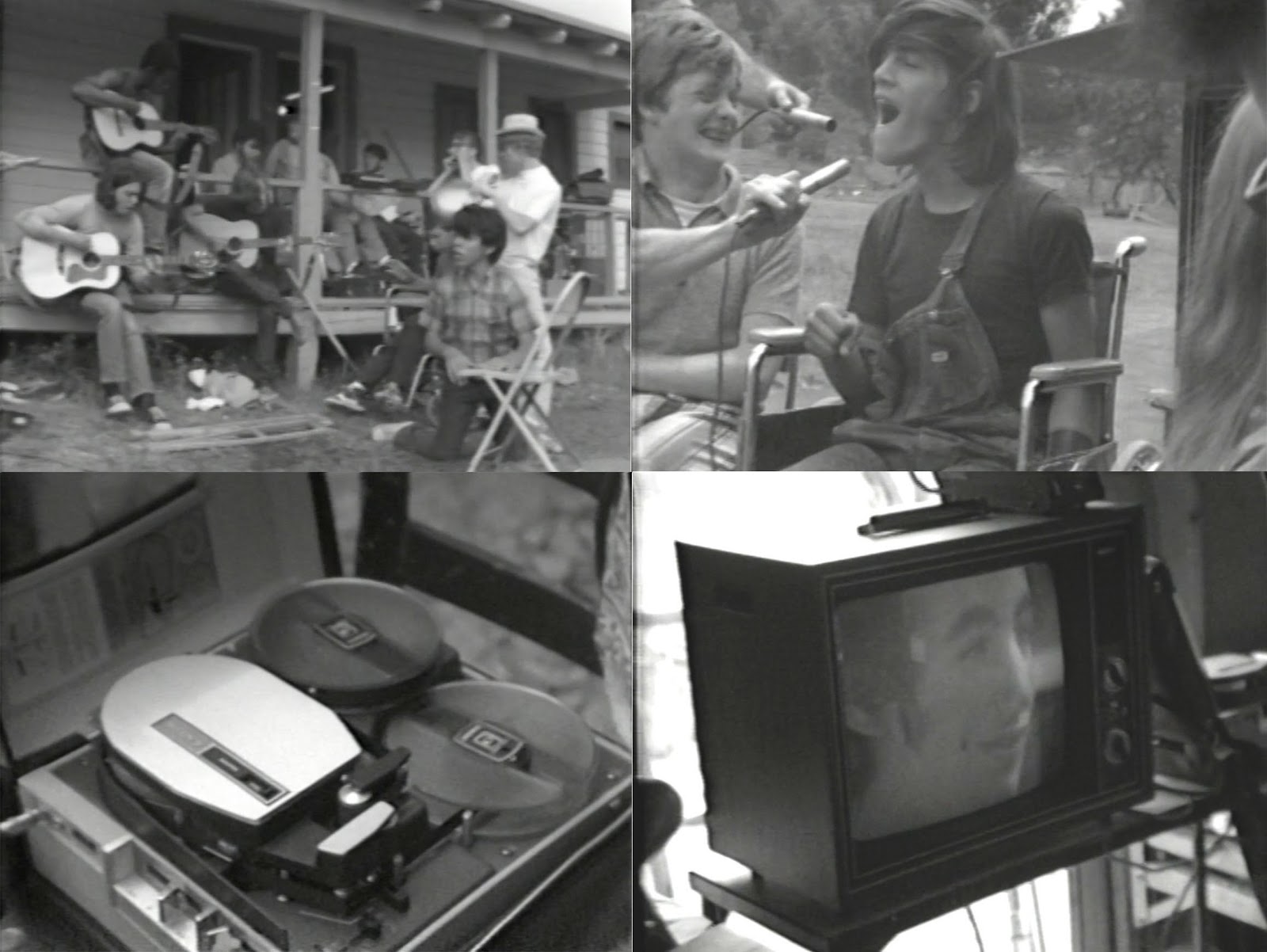
The People’s Video Theatre—a media activist group producing documentary film in New York State in the early 1970s—was responsible for introducing documentary cameras into the camp. Newnham and Lebrecht’s film collects archival footage recorded by the People’s Video Theatre and the campers themselves (including Lebrecht), featuring interviews, group discussions within the camp, as well as the very act of shooting using handheld cameras and the projection of the same footage within the camp itself. This feedback loop was essential to the activities of the People’s Video Theatre and other media activist groups operating at the time. The Sony PortaPak handheld camera, which had just been introduced in the market in 1967, was small, economical, and powered by batteries and thus radically transformed access to filming. The new camera was particularly decisive for documentary video since it simplified the work of filming outside of a studio. The impetus of the People’s Video Theatre, ignited by the new media, was aligned with other groups seeking to design and implement what were conceived as “alternate information structures,” which were expected to both record alternate lifestyles and reconfigure existing ones as “no more than products of the existing process.”14 The concern with new information structures exceeded an expended attention to the content of the films and their reception, to include also an interest in participatory processes and the opportunities allowed by direct audience feedback. These interests were explored to engage and provide discursive platforms to marginalized groups, in alignment with the political and cultural activism of the period.15
From the outset, the People’s Video Theatre expressed this concern with the whole process of information production and reception and allegedly aimed to “explore more responsive handling of information.”16 One of their first projects, for example, was concerned with the transformation of Washington Square Park and addressed the changing dynamics between different age and ethnic groups within it. The footage resulting from this film project was not only presented to different authorities, neighborhood groups, and the planning board but was also projected in the very square, in order to collect feedback from the community. The overall sequence was considered as a process of “video mediation,” in which, as Ken Marsh had it, “the people are the information; media processes can reach out to their needs.”17
Expanding these projects into their archival dimension, the People’s Video Theatre was interested in building “tape libraries” that would make footage available to different audiences (under the motto, “all media to the people”). The same pursuit for the redistribution of media content was evident in the group’s aim to participate in a large project for a “Center for Decentralized Television.” Managed by the Jewish Museum, the project would provide equipment to diverse groups throughout New York State (including, for example, upstate farmers) and subsequently facilitate access to the content that was produced.18 A broader impetus at the time aimed to grow “video data banks” that would transform not only the voices heard but also those preserved. The goal, as Chris Hill has suggested, was to challenge “a class-based notion of intellectual heritage.”19 Crip Camp takes advantage of one of these alternative archives together with additional footage, photographs, and contemporary interviews to both campers and counselors in order to contribute to an expansion of the history of the disability rights movement and provide an alternative representation of (and by) the disabled community.
“Personal assistance was built into all our lives.”20
If having campers participate in the process of recording challenged the traditional hierarchy between the eye of the filmmaker and the object of the film, the camp simultaneously disrupted traditional frameworks of authority. Famously characterized as a camp “run by hippies,” participants recall not being able to distinguish who was a camper and who was a counselor,21 and some counselors recall not having any particular experience with people with disabilities.22 The environment was the opposite of institutions in which the life of disabled individuals was often limited by strict frameworks of medical authority or paternalistic assistance.23 Disabled kids were regularly excluded from schools, relegated to infirmaries, or made subject to various hierarchies and forms of discrimination. In many cases, those exclusions were determined by the very architecture of the institutions, which, for example, forced classes for groups of disabled students to take place in the basement. Even the summer camps available for disabled children and teenagers at the time sustained similar hierarchies, with a clear-cut distinction between counselors, who would never be disabled, and campers, who were treated as patients.24
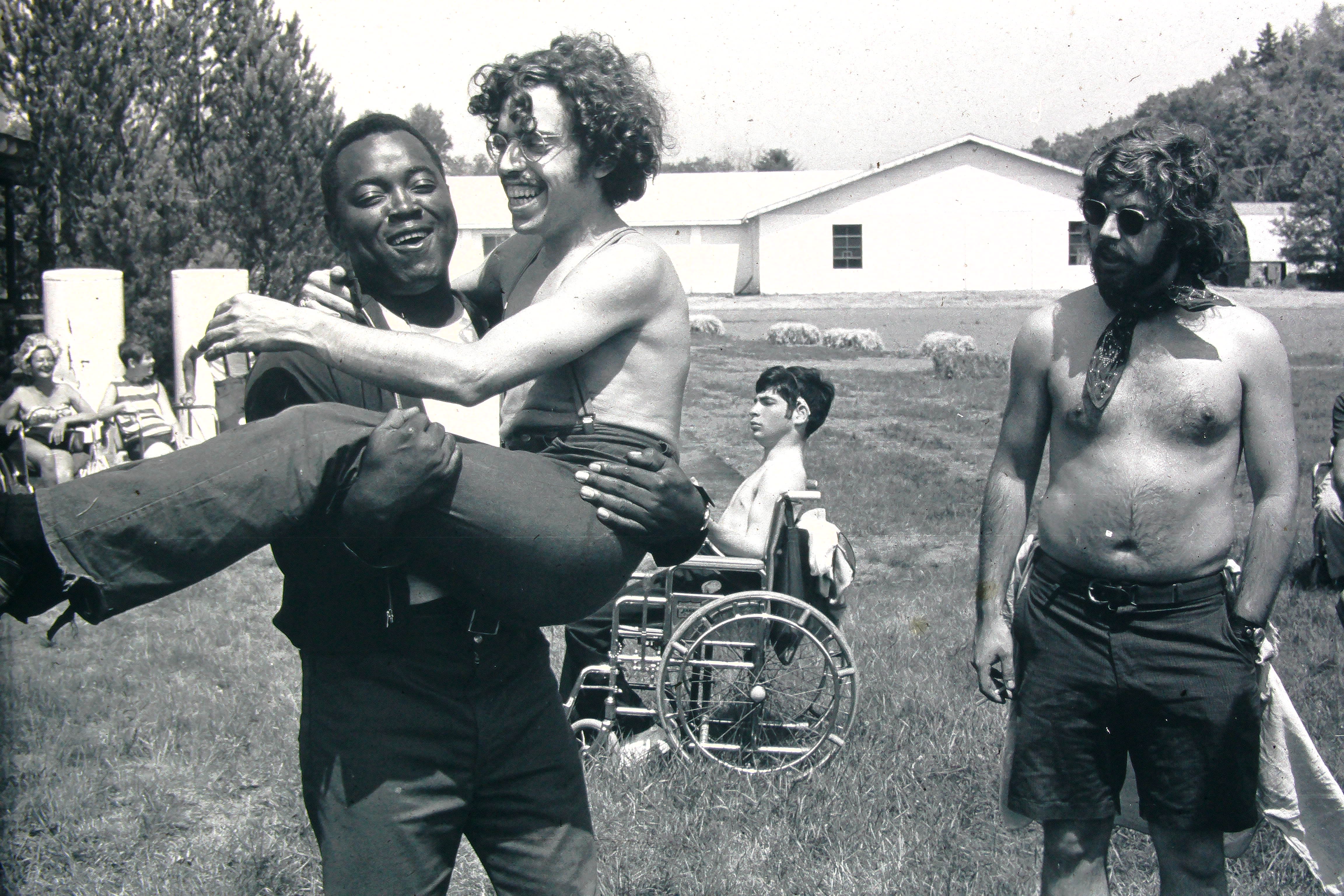
The community gathering in Camp Jened was not without its internal differences, and the film makes those evident throughout. Not all of the kids were accustomed to the same autonomy, not all of them could move alone, and their disabilities were not all equally visible, resulting in assumed hierarchies among the disabled community that, for example, put those with polio “ahead” of those with cerebral palsy.25 And yet, in lieu of these differences reinforcing frameworks of authority or condescending attitudes, the film depicts a world in which care and support were provided beyond the counselor/camper relation. Reinforcing what she saw as a fundamental contribution of the camp, Heumann reflects about the networks of interdependency within it, considering how “personal assistance was built into all our lives, who needed help.”26 For many of the campers, this was an opportunity to experience both helping and being helped by someone other than medical experts or family members and revealed their own expertise about their own needs.
The film describes the networks of assistance developing in Camp Jened along diverse forms of affection, friendship, and even romance. While in what Lebrecht calls “straight camps,” romantic relations were not facilitated to prevent “the disappointment of a relationship not working out,” for many of the campers, Camp Jened provided the context for their first romantic relationships.27 Beyond those, Crip Camp describes the formation of a community that challenged the diverse forms of segregation with which both campers and counselors struggled in their everyday life. The film, for example, features an African American counselor reflecting on the parallels between their different experiences of exclusion since racial segregation was still prevalent in many areas of the country and in diverse realms of public life. Privileging this analogical rather than intersectional framework, the film does not address how the diverse gender and racial identities of the campers affected their experiences.28
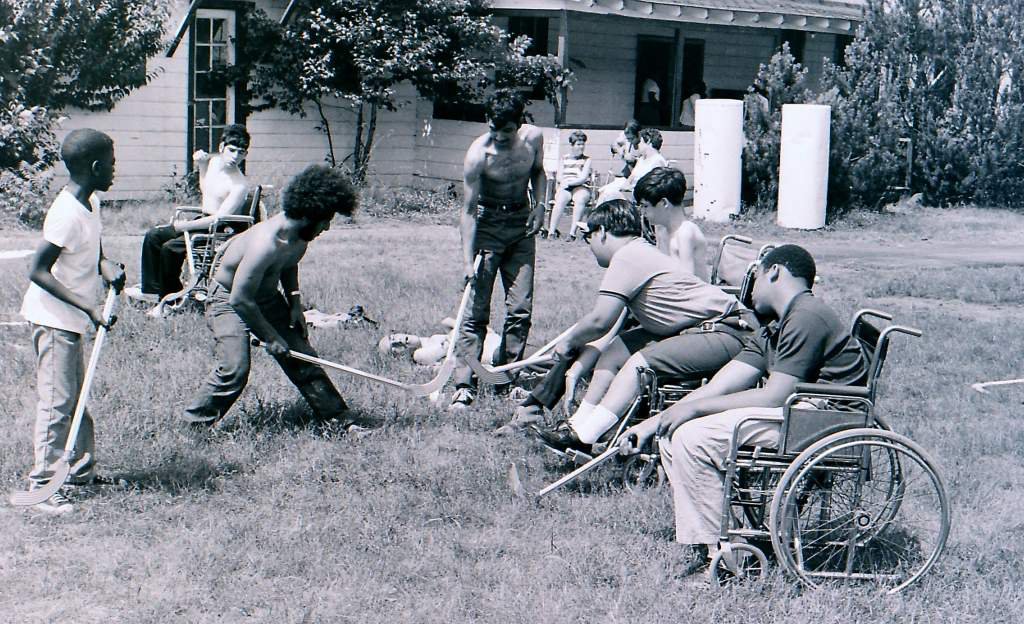
Physical spaces decidedly privileged these interdependent coalitions and the alternative imaginaries the camp fostered. Its logics and aesthetics decidedly countered those of medical institutions, with places to sleep called “bunks” rather than “dorms,” for example, and the nature of the living arrangements were in some ways left to the campers to organize.29 While ramps in front of each building provided access to the different verandas and allowed individuals in wheelchairs to move swiftly throughout the camp, not all spatial strategies sought to provide a smoother ground: Other, more playful interventions built traps that would make everyone trip—diffusing the difference between able and disabled bodies in the camp. These different features came to expand what Aimi Hamraie has called “the politics of surface texture” in their discussion of curb cuts and ramps—a political power that they argue “rests upon the production of friction and disorientation rather than smooth, neutral belonging.”30
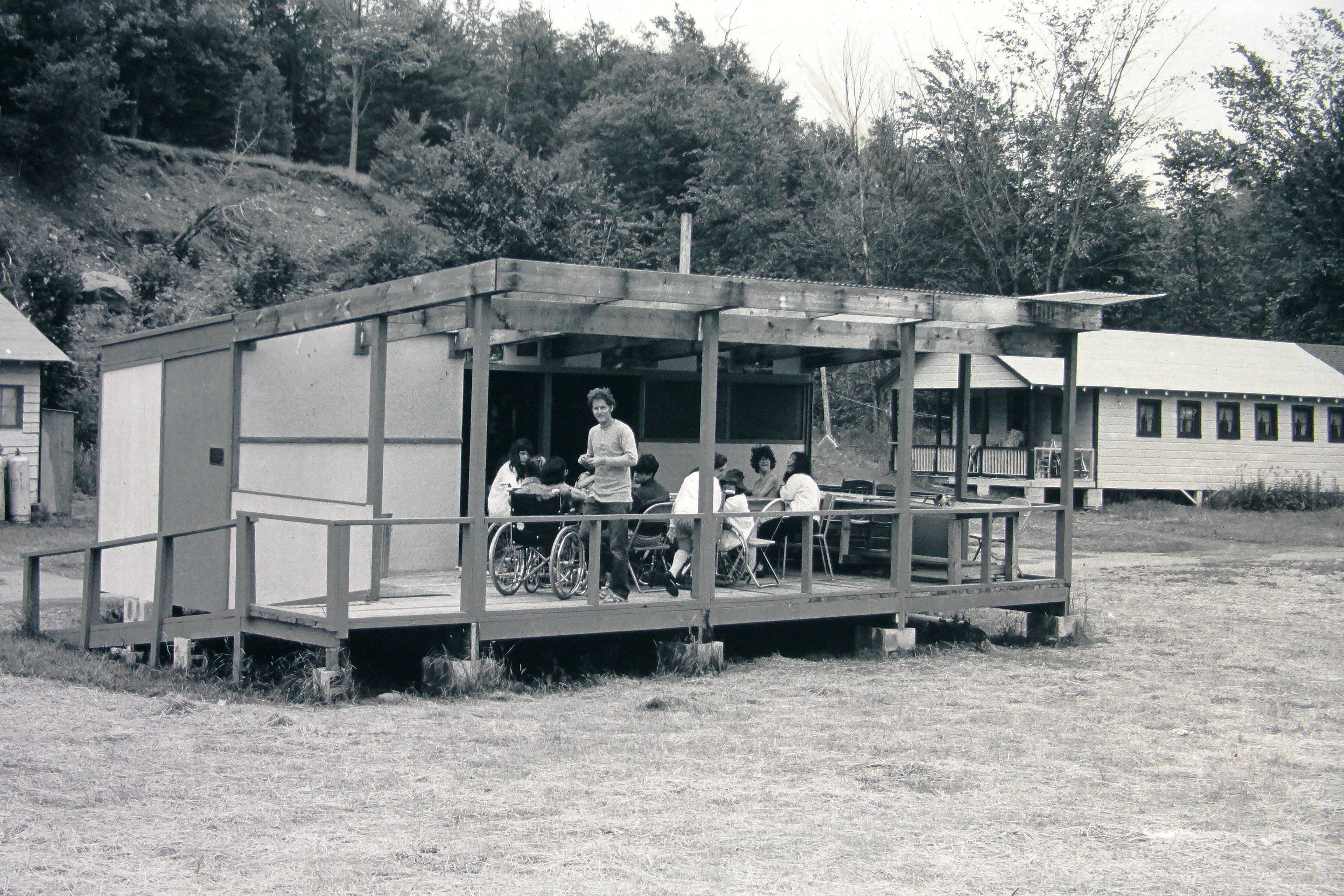
Both the social and physical space were significantly different inside and outside the camp. While campers allegedly lived as if “there was no outside world,” excursions to places in the vicinity faced campers with a reality where they encountered both material barriers and discrimination. The camp revealed itself as an exception, and campers repeatedly conceptualized it as a “bubble.” But beyond this understanding, the camp allowed rehearsing an alternative world for them to strive for. As Lebrecht put it: “You don’t have anything to strive for if you don’t know it exists.”31
“I had to fit into this world that wasn’t built for me.”32
Leaving this “bubble” and moving back home was a particular struggle for the disabled campers, some of whom recall, in the film, the feeling of returning “to a world in which it’s hard to get around,” one “that wasn’t built for me.”33 Moving away from Camp Jened, the film then narrates the struggle of disabled rights activists, including some campers, to turn that world around. The film portrays with particular attention the role played by Heumann, moving from camp counselor to prominent disability rights leader in the United States in the ensuing decades.34 With Disabled in Action (the political organization that she founded in 1970), Heumann spearheaded protests in New York City and Washington, prominently challenging Richard Nixon’s opposition to Section 504 of the Rehabilitation Act of 1973, which prohibited discrimination against people with disabilities in programs that receive federal financial assistance.
At that point, Heumann’s role came to the attention of disability rights activists in the Bay Area, and the film travels with her as she joined the Center for Independent Living.35 The emphasis of the independent living movement was on de-institutionalization rather than on autonomy, as it sought to empower diverse modes of interdependence similar to those rehearsed in the camp, with assistants and attendants strengthening the networks that would help disabled students live with other members of the community in Berkeley.36 The CIL led the protests in response to the failure of both the Nixon, Ford, and Carter administrations to develop the necessary regulations for the implementation of Section 504. Their challenge to spatial segregation was, this time, staged in the very spaces of power rather than away from them, as disabled individuals led by Heumann occupied the San Francisco Federal Building—in what turned out to be the longest sit-in in a federal government office in US history to date. Peter Trier, a member of the CIL, described the event as an occupation in which new forms of coexistence were not only pursued but also tested: “It was a beautiful experience characterized by shared emotions and loving concern; the depth of commitment of a group who was willing to take serious risks with their health and well-being for the sake of a shared belief moved me profoundly.”37
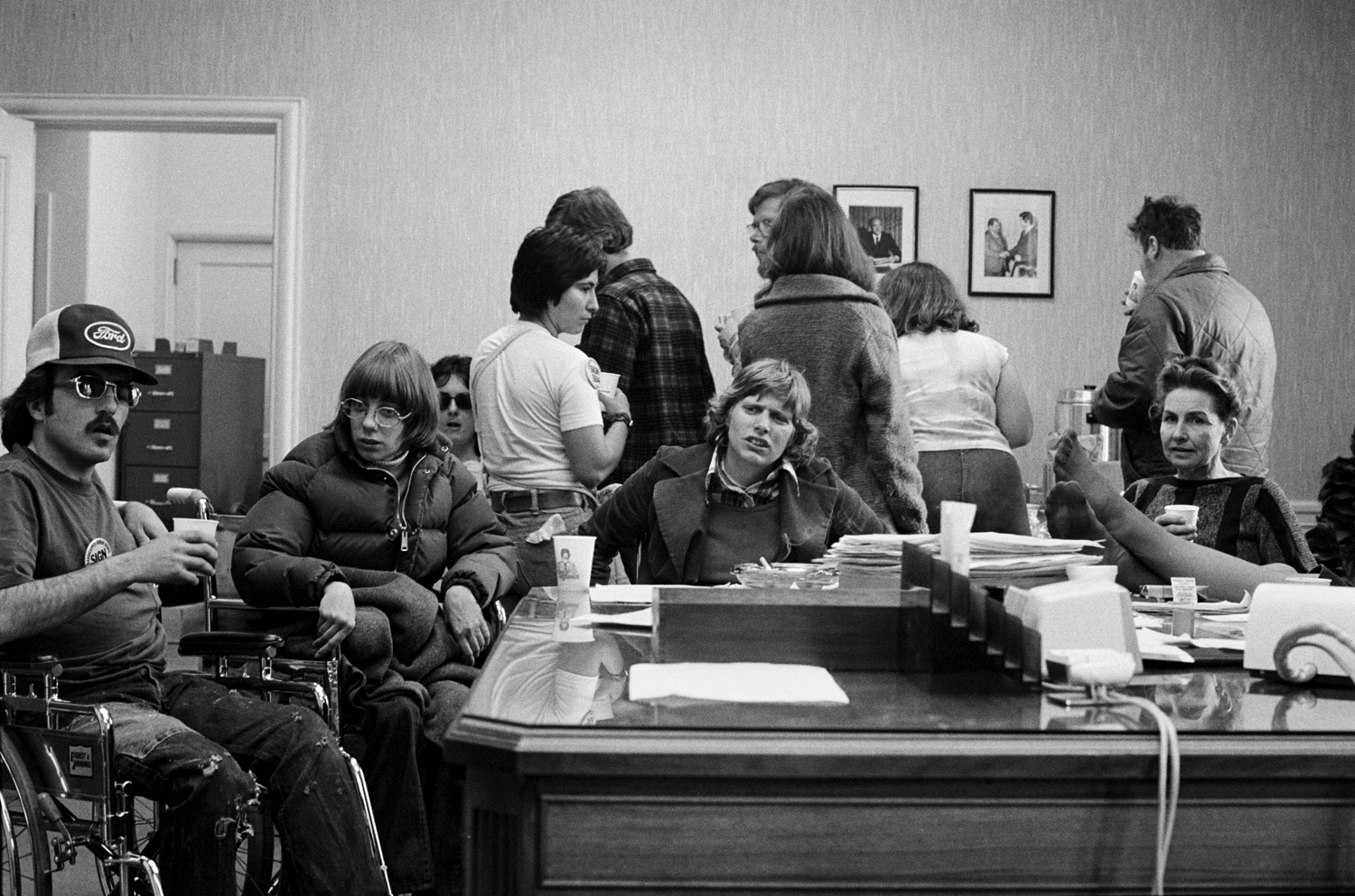
Those socialites involved critical coalitions not only within the disabled community but also between different civil rights movements. In fact, the film highlights the way in which the occupation intersected with the Black Panthers, members of different Unions, and the LGBTQ group Butterfly Brigades.38 Together, the occupiers took important risks together—including risks that directly related to the relationship between their bodies and space, the very relationships that concerned their protests: Some of the individuals had to live “without catheters, back-up ventilators, and the attendants who would move them every few hours to prevent bedsores, or who, with their hands, would cleanse impacted bowels every few days.”39 As historian Joseph Shapiro recounts, Mayor George Moscone brought in twenty air mattresses and hoses with shower heads, over the objections of the Health, Education, and Welfare regional director Joseph Maldonado, who complained: “We’re not running a hotel here.’”40 Rather than relying on others to figure out their living environments, as in a hotel, disabled individuals had to figure out, by themselves, how to live—relying on camplike networks of care and support. Linking the experiences of the camp and the sit-in, the film makes an important contribution to the larger disability justice conversation by depicting a world with the space—and need—for different forms of support and coalitions, whose relevance extends beyond the pursuit of rights alone.
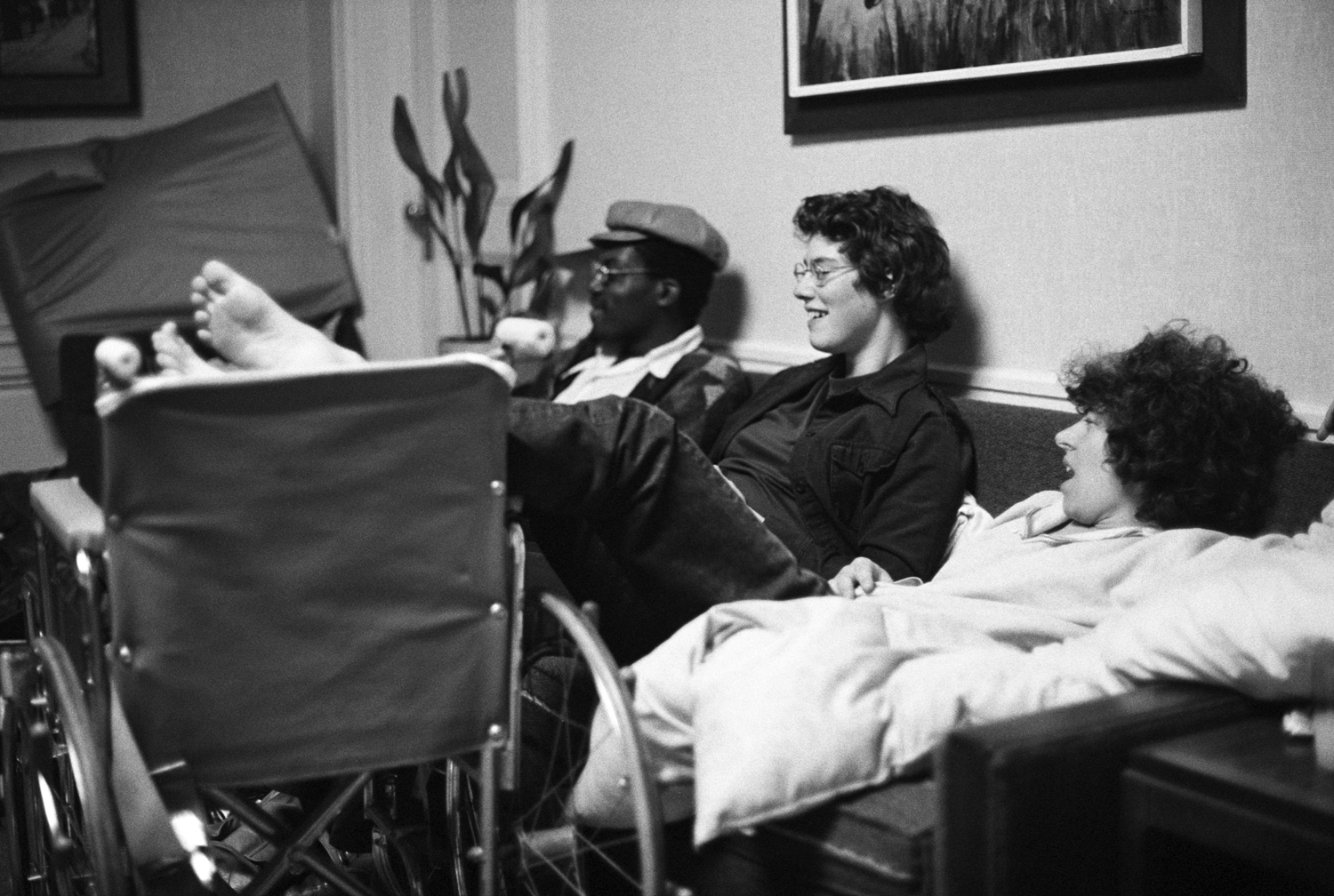
When introducing the projection of the People’s Video Theatre at Camp Jened, Heumann invited campers to engage in this innovative feedback loop: “Whatever you want to say, let us know. Let’s have a lot of interaction.” It would have been difficult to predict the imaginations that the projection would trigger for new ethico-political frameworks, and the legal transformations that would follow with the success in defending the implementation of Section 504 and, ultimately, with the approval of the Americans with Disabilities Act. And yet, the struggle continues, beyond the introduction of an accessible bathroom or a hidden ramp in every plan. Toward the end of the film, Heumann powerfully captures the ongoing strife, in ways that bring to the fore the relation between architectural and political stakes in the fight for disability justice. Evaluating the achievements of the 504 sit-in at the time, she stated, “I should say everything is wonderful … . [But] I am very tired of being thankful for accessible toilets. [If] I have to feel thankful about an accessible bathroom, how am I going to be equal in the community?” Crip Camp expands current concerns with accessibility and inclusion beyond the provision of technical solutions inscribed in legal frameworks, offering a forceful alternative to pervasive ableist imaginaries.
-
Aimi Hamraie argues that “working in concert with post-racial narratives, which insist that American racism ended along with state-sanctioned segregation, the post-ADA narrative uses the formal guarantee of disability equality to elide the existence of material inequalities.” Aimi Hamraie, Building Access: Universal Design and the Politics of Disability (Minneapolis: University of Minnesota Press, 2017), 3. ↩
-
David Gissen highlights how disabled individuals are absent from architecture’s academic and professional institutions and “statistically invisible,” pointing out that the report, “Inclusion in Architecture,” that has recently been produced by the J. Max Bond Center on Design for the Just City at the Bernard and Anne Spitzer School of Architecture at the City College of New York, did not include disability among its areas of concern. For him, this exclusion of disabled architects and architecture students “relegates people with disabilities to being a topic of discussion versus agents of change.” See David Gissen, “Inclusion in Architecture: Why Are There So Few Disabled Architects and Architecture Students?” the Architects Newspaper, June 15, 2018, link. ↩
-
Jos Boys, Disability, Space, Architecture: A Reader (New York: Routledge, 2017). ↩
-
Alison Kafer, Feminist, Queer, Crip (Bloomington: Indiana University Press, 2013), 2. ↩
-
See Paul Abberley, “The Concept of Oppression and the Development of a Social Theory of Disability,” Disability, Handicap, & Society, vol. 2, no. 1 (1987), 5–19 and Michael Oliver, “Changing the Social Relations of Research Production?” Disability, Handicap, & Society, vol. 7, no. 2 (1992), 101–114. Kevin Gotkin has eloquently explained the social model of disability in this very publication. See Gotkin, “Stair Worship: Heatherwick’s Vessel,” in the Avery Review 33 (September 2018), link. I am grateful to Kevin for his comments during the preparation of this article. ↩
-
Kafer, Feminist, Queer, Crip, 6. ↩
-
The film, which will be available on Netflix in 2020, has been produced by Nicole Newnham, James Lebrecht, and Sara Bolder, with executive production by Barack and Michelle Obama’s Higher Ground Productions Company and Netflix. It premiered at Sundance’s opening night selection on January 23 for the 2020 festival (where it received the Audience Award) and was presented in New York at MoMA’s DocFortnight’s opening night on February 5, where it congregated a large crowd of former campers. ↩
-
This review follows a conversation with Jim Lebrecht in the summer of 2018, in which I had the chance to learn about his experiences in Camp Jened. I am deeply indebted to this conversation in my understanding of the film, though any misinterpretations of its ambitions are my own. See Ignacio G. Galán and Jim Lebrecht, “Crip Camp: An Interview with Jim Lebrecht,” Ed 3: Normal (2020), 22–27. I was originally introduced to Jim Lebrecht by Raymond Lifchez while doing research on the Center for Independent Living (CIL) and its collaboration with the College for Environmental Design at U.C. Berkeley (which Lifchez sponsored), which will be published in Kathleen James-Chakraborty and Ignacio G. Galán, “Every Body Needs Equal Access,” in Beatriz Colomina, Ignacio G. Galán, Evangelos Kotsioris, and Anna-Maria Meister ed., Radical Pedagogies (Berlin: Sternberg Press, forthcoming 2021). ↩
-
See “A Word on Words,” in the Berkeley Revolution: A Digital Archive of One City’s Transformation in the Late-1960s & 1970s, link. See also Raymond Lifchez and Barbara Winslow, Design for Independent Living: The Environment and Physically Handicapped People (Berkeley: University of California Press, 1979), 9. While already used in the origins of the disability rights movement, the term has come to indicate an area of study and a theoretical framework. Developing in parallel to queer theory, crip theory aims “to resist the contemporary spectacle of able-bodied heteronormativity.” See Robert McCruer, Crip Theory: Cultural Signs of Queerness and Disability (New York: New York University Press, 2006), 3. ↩
-
Ken Marsh, “Alternatives for Alternate Media: People’s Video Theater Handbook,” Radical Software, vol. 1, no. 2 (1970), 18, link. ↩
-
Bree Hadley and Donna McDonald: “Introduction: Disability Arts, Culture, and Media Studies—Mapping a Maturing Field,” in The Routledge Handbook of Disability Arts, Culture, and Media, ed. Bree Hadley and Donna McDonald (Abingdon, Oxon: Routledge, 2019), 1. ↩
-
See Judith E. Heumann with Katherine Salinas and Michellie Hess, “Road Map for Inclusion: Changing the Face of Disability in Media,” Ford Foundation report, 2019, link, 2 and 13. This report included data from the Centers for Disease Control and Prevention as well as the GLAAD Media Institute. As I will discuss later in this review, Judith Heumann was particularly involved in the 1977 fight for the issuance of regulations regarding Section 504 of the Rehabilitation Act of 1973, which opened the path for the signature of the ADA more than a decade later. ↩
-
The relation between documentary film and the mirror image that it provided for this group of teenagers could be extended through Friedrich A. Kittler’s reading of the Lacanian imaginary in relation to media technologies. See Kittler, “Gramophone, Film, Typewriter” in Literature, Media, Information Systems (Amsterdam: G+B Arts, 1997), 45. ↩
-
Phyllis Gershuny and Beryl Korot, Radical Software, vol. 1, no. 1 (1970), link. ↩
-
Chris Hill, “Dialogue Across Decades: BLW and People’s Communication Network-Exercises in Remembering and Forgetting,” Journal of Film and Video, vol. 64, no. 1/2 (Spring/Summer 2012): 21. ↩
-
Marsh, “Alternatives for Alternate Media.” ↩
-
Marsh, “Alternatives for Alternate Media.” Consequent endeavors were framed as “Environmental, Cultural, and Campus Mediation Projects,” which were understood to address diverse areas of concern at the time. ↩
-
See Paul Ryan, “A Genealogy of Video” in Leonardo, vol. 21, no. 1 (1988), 42–43. ↩
-
Hill, “Dialogue Across Decades,” 21. The term “video data bank” was originally coined at the time in the aforementioned article Gershuny and Korot, Radical Software, 1. ↩
-
Judith E. Heumann in Crip Camp. ↩
-
Galán and Lebrecht, “Crip Camp,” 24. ↩
-
The camp gathered around 120 campers from the US East Coast, the Midwest, and Canada, though the majority came from New York. While initially open to children, teenagers, and adults, it was mostly attended by teenagers. Campers came from diverse socio-economic backgrounds, and most of them had to pay, even with some scholarships sponsored by the Jened Foundation. Participants joined the camp for periods of four to eight weeks. Counselors were recruited though newspaper ads, and while some of those interviewed in the film referred to their lack of experience, others had previously worked in the field as social workers. See Larry Allison, Camp Jened administrator, deputy director at New York City Mayor’s Office for People with Disabilities, 1973–1991, an oral history conducted by Denise Sherer Jacobson in 2001, in New York Activists and Leaders in the Disability Rights and Independent Living Movement, vol. I, Regional Oral History Office, The Bancroft Library, University of California, Berkeley (2004), 18. ↩
-
While the quality of these institutions and the attention and care provided within them varied immensely, the film highlights the infamous case of the Willlowbrook State Hospital in NYC, where disabled individuals lived in gruesome conditions of virtual abandonment. ↩
-
Galán and Lebrecht, “Crip Camp,” 23. ↩
-
The film addresses these hierarchies humorously through the memories of some campers. Others recall them being less noticeable in Camp Jened than in other places. See Larry Allison, oral history conducted by Denise Sherer Jacobson, 20. ↩
-
Sunaura Taylor and Judith Butler have reflected on this experience of interdependency in a conversation in the film Examined Life, dir. Astra Taylor (2008). Taylor and Butler’s conversation is available at link. Taylor: “In my opinion, help is something we all need… and we are all interdependent in all sorts of ways.” Butler: “My sense is that what’s at stake here is really rethinking the human as a site of interdependency… Do we or do we not live in a world in which we assist each other?” ↩
-
Galán and Lebrecht, “Crip Camp,” 23. For some campers, this was also the context of their first sexual relations as they came of age. As former director Larry Allison recalls, “I remember very, very distinctly—and this is in adult camp—a couple who wanted to have sex, and the counselor came to me and said, ‘So-and-so and So-and-so want to have sex, and they can’t do it themselves; they want me to help them.’ I said, ‘So why are you telling me? It’s none of my business. They’re adults.’ Now, I said that, and I meant that, and in the back of my head, as the director of the camp, I thought, ‘Oh, my God, I’m gonna get sued on this. I don’t want the lawyers to even know about this.’” See Larry Allison, oral history conducted by Denise Sherer Jacobson, 16. ↩
-
For a discussion of a shift in addressing the relation between race and disability see Angela Frederick, Dara Shifrer, “Race and Disability: From Analogy to Intersectionality,” Sociology of Race and Ethnicity, vol. 5, no. 2 (2018): 200–214. For an expanded discussion of the intersections between race and disability see, for example, Chris Bell ed., Blackness and Disability: Critical Examinations and Cultural Interventions (East Lansing: Michigan State University Press, 2011). ↩
-
Galán and Lebrecht, “Crip Camp,” 24. ↩
-
Hamraie, Building Access, 103. They borrow the term “disorientation” from Sara Ahmed, Queer Phenomonology: Orientations, Objects, Others (Durham, NC: Duke University Press, 2006), 166. ↩
-
Galán and Lebrecht, “Crip Camp,” 25. ↩
-
James Lebrecht in Crip Camp. ↩
-
James Lebrecht in Crip Camp. ↩
-
Heumann, who had managed to enter high school in 1961 at the same time that African Americans were working to upend decades of segregation, attained wider public prominence when she filed a suit against the Board of Education of the City of New York after being denied access to a teaching position. After increased attention by the media (with the Daily News publishing the article “You can be president, not teacher, with polio," Heumann won the case. See Joseph P. Shapiro, No Pity: People with Disabilities Forging a New Civil Rights Movement (New York: Times Books, 1993). ↩
-
Heumann joined the CIL following an invitation from one of its founders, Ed Roberts, who had led the fight for disability rights at the University of California, Berkeley, in the 1960s. Shapiro, No Pity, 58. ↩
-
See Hamraie, Building Access, 112. Importantly, the independent living movement did not aim to counter dependency and, even if it appropriated its name from former rehabilitationist programs, it aimed to define “a political position against compulsory productivity,” Hamraie, Building Access, 115. ↩
-
Peter Trier paraphrased in Raymond Lifchez and Barbara Winslow, Design for Independent living: The Environment and Physically Disabled People (New York: Whitney Library of Design, 1979), 25. ↩
-
For a discussion of these intersections see, for example, Susan Schweik, “Lomax’s Matrix: Disability, Solidarity, and the Black Power of 504,” Disability Studies Quarterly, vol. 31, no. 1 (2011), link. ↩
-
Shapiro, No Pity, 67. ↩
-
Shapiro, No Pity, 67. ↩
Ignacio G. Galán is an architect and historian. He is assistant professor at Barnard College, Columbia University. His work studies the relation between architecture, politics, and media with a focus on nationalism, colonialism, migration, diversity, and inclusion.

